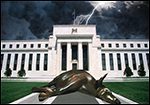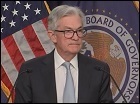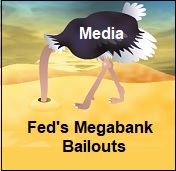-
Recent Posts
- Trump’s “Big Beautiful Bill” Is a Grotesque Giveaway to Fossil Fuel Billionaires While Adding $3.3 Trillion to Nation’s Debt
- Senator Chris Murphy Charges that Trump “Has Opened a Channel for Bribery”
- Congressman Casten: Trump’s Assault on the Rule of Law Is Causing Capital Flight Out of U.S. by Foreign Investors
- Trump’s Approval Rating Drops to 80-Year Low; IMF Says U.S. Tariffs Now Exceed the Highs During the Great Depression
- Nasdaq Has Lost More than 3,000 Points Since Trump’s First Full Day in Office in 2025; the Pain Has Barely Begun
- The Bond Crisis Last Week Was a Global No-Confidence Vote in U. S. President Donald Trump
- Trump’s Tariff Plan Guts $5 Trillion in Stock Value in Two Days; Senator Warren Calls for Emergency Action Before Markets Open on Monday
- Trump’s Attacks on Big Law, Universities, and the Media Have a Common Goal: Silence Dissent Against Authoritarian Rule
- Trump Administration Gives All Clear to Laundering Money through Shell Companies and Bribing Foreign Officials
- Four Megabanks on Wall Street Hold $3.2 Trillion in Uninsured Deposits – Which May Explain Senator Schumer’s Pivot to the GOP to Stop a Government Shutdown
- Here’s What Came Crashing Down Yesterday for Trump’s “Genius” Guy, Elon Musk: Tesla Stock, Access to Twitter (X), His Years of Secret Calls with Putin
- After Banning the Associated Press, Trump Is Now Targeting Specific Journalists That He Wants to See Fired
- Closely Watched Atlanta Fed Model Predicts Negative U.S. Growth in First Quarter
- Trump’s Gangster Diplomacy Makes Front Page Headlines Around the Globe
- Who Benefits Alongside Elon Musk If He Succeeds in Killing the CFPB: the Megabanks on Wall Street that Underwrite His Tesla Stock Offerings
- In Trump 1.0, the State Department Used Taxpayer Money to Publish a Book Elevating Elon Musk to a Superhero; It Was Funded by USAID, the Agency Musk Wants to Quickly Shut Down
- News Host Joy Reid Raises Threat of Trump Selling U.S. to Putin; Ten Days Later Her Show Is Cancelled
- Elon Musk’s DOGE Appears to Be Violating a Court Order; It Has Taken Down Hundreds of YouTube Videos that Educate Americans on How to Avoid Being Swindled
- Barron’s Releases Audio of Jamie Dimon Cursing Out His Workers at a Town Hall, as Dimon Plans to Dump Another One Million JPM Shares
- There’s One Federal Investigative Agency that Neither Trump nor Elon Musk Can Touch: It Just Opened an Investigation into DOGE
- Elon Musk’s Companies Were Under Investigation by Five Inspectors General When the Trump Administration Fired Them and Made Musk the Investigator
- Donald Trump Gives the Greenlight to Goldman Sachs and JPMorgan Chase to Return to Bribing Foreign Officials
- After Tech Geeks Built a Back Door to Loot Billions from FTX, Republicans Refuse to Investigate What Elon Musk’s Tech-Squad Did Inside the U.S. Treasury’s Payment System
- Former Prosecutor, Now U.S. Senator, Informs Tesla That CEO Musk May Be Violating Federal Law and to “Preserve All Records”
- Trump’s Hedge Fund Guy Is Now Overseeing the U.S. Treasury, IRS, OCC, U.S. Mint, FinCEN, F-SOC, and the Consumer Financial Protection Bureau
- As Elon Musk Begins Shutting Down Payments to Federal Contractors, a Strange Money Trail Emerges to His Operatives Inside the U.S. Treasury’s Payment System
- JPMorgan Chase Charged by Yet Another Internal Whistleblower with Cooking the Books
- We Asked Google’s AI Search Model, Gemini, Questions About the Fed and Wall Street Megabanks: It Got the Answers Dead Wrong
- With Trump and Melania’s Crypto Coins Likely to Raise Legal Challenges, Why Didn’t Trump Fire the SEC’s Inspector General in His Purge of IGs?
- Fossil Fuel Industry Could End Up Paying Tens of Billions for LA Wildfires and Deceiving the Public on Climate Change for Decades
- It’s Being Called the Biggest Grift by a President in U.S. History: Trump and First Lady Launch their Own Crypto Coins
- Trump Plans to Install a Fracking CEO to Head the Energy Department and Declare a National Emergency on Energy to Gain Vast Powers
- Fossil Fuel Money Played a Role in the Los Angeles Fires and the Push to Install Pete Hegseth as Secretary of Defense
- When It Comes to Wealth Retention in Retirement, Concrete May Be the New Gold
- Wall Street Watchdog Warns “Clock Is Ticking on a Coming Catastrophic Financial Crash”
- Wall Street Is Sending the Same Message to Americans on Fossil Fuel Financing that It Sent on Cigarettes: Drop Dead
- In a Six-Week Span, this Dark Pool with a Curious Past Traded 3.7 Billion Shares
- Wall Street’s Lobby Firm Hired Eugene Scalia of Gibson Dunn to Sue the Fed for Jamie Dimon
- Postmaster General Louis DeJoy Made $561,051 in Compensation in 2024, as Mail Costs Spiked and Delivery Deteriorated
- Fed Chair Jay Powell Sends a Bold Message to Trump and Tanks the Dow by 1123 Points
- The Head of Fixed Income at T. Rowe Price Makes the Scary Case for the 10-Year Treasury to Spike to 6 Percent
- $663 Billion in Cash Assets Have Gone Poof at the Largest U.S. Banks
- Donald Trump to Ring Bell at New York Stock Exchange Today as Hit List Posters Appear in Manhattan Targeting Wall Street CEOs
- Trump Has a Slush Fund to Prop Up the Dollar – Will He Use It to Prop Up Bitcoin Instead?
- A CEO Assassination; a Billionaire Heiress/NYPD Commissioner; a Secret Wall Street Spy Center – Here’s How They’re Connected
- Despite More than 1600 Tech Scientists Signing a Letter Calling Crypto a Sham, Trump Names a Crypto Cheerleader for SEC Chair
- The Fed Rings a Warning Bell: Hedge Funds and Life Insurers Are Reporting Historic Leverage
- Trump’s Nominee for FBI Director, Kash Patel, Has Businesses Financially Intertwined with Trump
- Donald Trump Is at Risk of Getting Named in a Fossil Fuels Conspiracy Lawsuit
- Trump Is Having Difficulty Getting a Lawyer to Accept the Nomination for SEC Chair: Here’s Why
Search Results for: Federal Reserve
Citigroup May Slash 24,000 Jobs; Its Stock Has Lost 92 Percent Since January 2007

By Pam Martens and Russ Martens: November 7, 2023 ~ On the first day of trading in January 2007 (the year prior to the Wall Street financial crisis in 2008 that saw century-old iconic financial firms explode one after another), Citigroup closed the trading day at $55.25. Yesterday, Citigroup’s common stock closed at an effective share price of $4.20. Citigroup did a 1-for-10 reverse stock split on May 9, 2011. That means that investors holding 100 shares of Citigroup back in January 2007 saw their position shrink to 10 shares after May 9, 2011. So yesterday’s closing price of $42.04 for Citigroup is effectively $4.20 for long-term shareholders, adjusting it for the reverse stock split. To put that in even starker terms, investors who have held onto this dog for almost 17 years have watched 92 percent of its share price vanish. More dire news on Citigroup came yesterday with a … Continue reading
After Two Years, There’s Still No Law Enforcement Report on Former Dallas Fed President Robert Kaplan’s Trading Like a Hedge Fund Kingpin

By Pam Martens and Russ Martens: October 31, 2023 ~ To understand how truly bizarre and alarming the trading scandal case involving former Dallas Fed President Robert Kaplan is, some important background is necessary: Kaplan didn’t just trade in and out of stocks while a voting member of the interest-rate setting committee of the Fed (known as the Federal Open Markets Committee or FOMC); Kaplan also traded in and out of $1 million+ lots of S&P 500 futures. That is astonishing; unprecedented; and lacks any viable justification for a sitting Fed official. (See Kaplan’s financial disclosure forms from 2015 through 2020 while employed at the Dallas Fed.) Kaplan resigned from the Dallas Fed in September 2021, the same month that the trading scandal went viral in the news. S&P 500 futures allow an individual to trade almost around the clock from Sunday evening to Friday evening, unlike stock exchanges in the U.S. … Continue reading
The Dow Went Negative for the Year on Friday. One-Third of the Dow Is Down by Double-Digits.

By Pam Martens and Russ Martens: October 24, 2023 ~ The Dow Jones Industrial Average of 30 big-cap stocks closed out last year on Friday, December 30, 2022 at 33,147.25. After setting a year-to-date low of 31,819.14 on March 13 of this year during the banking crisis (a negligible decline of 4 percent year-to-date), the Dow climbed its way back to a year-to-date high of 35,630.68 on August 1. Since then, the Dow has been setting sharply lower lows – a sign of deterioration in its components. The Dow again went negative year-to-date last Friday, October 20, closing at 33,127.28. Equally notable, 20 components of the Dow 30, or two-thirds of the components, were negative year-to-date as of the close yesterday, October 23. Ten of the Dow’s components were down by double-digits year-to-date, through October 23. (See chart below.) The Dow index reading would be looking far worse were it not for … Continue reading
Fed’s Financial Stability Report Says $20.3 Trillion Is Subject to a Run

By Pam Martens and Russ Martens: October 24, 2023 ~ Last Friday, the Federal Reserve published its Financial Stability Report, which takes a detailed look at U.S. financial stability through the second quarter of this year. Although the Fed does its best to put a rosy glow on the outlook, it’s not a pretty picture. We found the most disturbing sentence in the report to be the following: “Overall, estimated runnable money-like financial liabilities increased 3.4 percent to $20.3 trillion (75 percent of nominal GDP) over the past year.” Given that a handful of banks this past spring, with combined liabilities of less than $1 trillion, caused a full blown banking panic and bank runs, the Fed’s figure of $20.3 trillion of “runnable” money is not a comforting thought. The Fed elaborates as follows: “The banking industry maintained a high level of liquidity overall, but some banks continued to face funding pressures; meanwhile, structural vulnerabilities … Continue reading
Regional Bank Stocks Plunge on Friday; More Pain Ahead as 10-Year Treasury Note Trades at a 5 Percent Yield This Morning

By Pam Martens and Russ Martens: October 23, 2023 ~ As the chart above indicates, Friday was not a good day to own regional bank stocks. The percentage declines are just for the one day of trading on Friday — not the year-to-date percentage losses. After the bank runs this past spring at regional banks brought on the second, third and fourth largest bank failures in U.S. history, things had quieted down in recent months. Then, along came earnings announcements last week, showing renewed struggles among the regional banks. One of the big losers for the week was Zions Bancorp. Its shares plunged 9.7 percent on Thursday and another 7.07 percent on Friday. The bank posted poor year-over-year comparisons on net interest income as it experienced rising expenses to compete for deposits. Another plunging bank stock on Friday was Regions Financial. The bank is facing continuing pressure on its net interest income. … Continue reading
Bank of America’s Deposits Fall, But at Slower Pace than JPMorgan Chase

By Pam Martens and Russ Martens: October 17, 2023 ~ Bank of America is the second largest bank by assets in the United States, topped in assets by only JPMorgan Chase. Both mega banks have seen a steady decline in deposits since the first quarter of 2022. But the decline in deposits at Bank of America represents just 65 percent of the deposit outflows that have occurred at JPMorgan Chase in the past seven quarters. (Bank of America, as the chart above shows, did report a small uptick in deposits in the current quarter.) At the end of the first quarter of 2022, Bank of America held $2.046 trillion in deposits. According to the 8-K filing the bank made with the Securities and Exchange Commission this morning, as of September 30, 2023 Bank of America’s deposits had declined to $1.885 trillion, a shrinkage of $161 billion. In the same span of time, … Continue reading
Fed’s Vice Chair for Supervision Says Another Financial Crisis Could Cost U.S. $5 Trillion to $25 Trillion – Potentially as Much as 100 Percent of GDP

By Pam Martens and Russ Martens: October 12, 2023 ~ On Monday, Michael Barr, the Vice Chair for Supervision at the Federal Reserve, addressed a contentious issue in a speech before the American Bankers Association’s annual convention in Nashville. The topic was why federal banking regulators have proposed higher capital levels for the largest U.S. banks, those with assets over $100 billion. As we reported on September 20, there has been aggressive pushback on the proposal from large banks, their lobbyists and their trade associations. (Community banks are not impacted by the proposal.) During his speech, Barr put a staggering dollar figure on the destruction to the U.S. economy that could materialize from another major financial crisis. Barr said this: “Research suggests the costs of a financial crisis are sizable. While estimates vary widely, the cumulative loss in economic activity is consistently estimated to lie above 20 percent of annual GDP—and in … Continue reading
Janet Yellen’s Treasury Department Hires 5-Count Felon JPMorgan Chase to Look for Fraud

By Pam Martens and Russ Martens: October 11, 2023 ~ Immediately upon departing her post as Chair of the Federal Reserve, but prior to getting the nod from the Biden administration to become U.S. Treasury Secretary, Janet Yellen engaged in what the courageous reporter at ProPublica, Jesse Eisinger, called a “two-fisted money grab from banks.” Yellen raked in more than $7 million in speaking fees with the bulk of that coming from Wall Street banks and trading houses, including JPMorgan Chase. In a Tweet, Eisinger said: “This is corruption, but isn’t called that because it’s so quotidian.” Now there is the appearance that a quid pro quo is coming full circle. According to a press release posted on JPMorgan Chase’s website, “it has been designated by the United States Treasury Department under a financial agency agreement to provide account validation services for federal government agencies” in order to ensure “Treasury’s commitment to … Continue reading
International Bank Study, Using 150 Years of Data, Shows Mega Banks Like the Big Four in the U.S. Produce Financial Instability and More Severe Crises

By Pam Martens and Russ Martens: October 9, 2023 ~ It took eight years of research to compile a data set of annual balance sheets of more than 11,000 commercial banks dating back to 1870 in 17 advanced economies. And in every country, the study arrived at the same finding: concentrating the banking system in the hands of five or less giant banks leads to financial instability and more severe financial crises. The bank balance sheets of the following countries were examined: Australia, Belgium, Canada, Denmark, Finland, France, Germany, Italy, Japan, Netherlands, Norway, Portugal, Spain, Sweden, Switzerland, the United Kingdom, and the United States. The 150-year banking study is titled: “Survival of the Biggest: Large Banks and Financial Crises.” Its authors are Matthew Baron of Cornell University; Moritz Schularick of the Kiel Institute for the World Economy and Sciences; and Kaspar Zimmermann of the Leibniz Institute for Financial Research SAFE. Other … Continue reading
After Getting the Largest Bailout in U.S. History in 2008, 85.5 Percent of the $1.34 Trillion in Deposits at Citigroup’s Citibank Lack FDIC Insurance Today

By Pam Martens and Russ Martens: October 5, 2023 ~ As evidenced by the speech that the FDIC Chair, Martin Gruenberg, delivered at a conference yesterday, the FDIC is very much aware that both the level of uninsured deposits and the concentration of those uninsured deposits among a handful of mega banks is a serious problem for the U.S. banking system. Gruenberg didn’t name names, but we will do that in this article. Gruenberg pointed out in his speech that year-end data for the three banks that failed this past spring indicated that anywhere from 90 percent to 70 percent of their deposits were uninsured. (During a banking panic, uninsured deposits are typically those that head for the exits at the fastest clip.) But those three failed banks (Silicon Valley Bank, Signature Bank and First Republic Bank) were minnows compared to the asset-size of the banking whales which now account for … Continue reading

